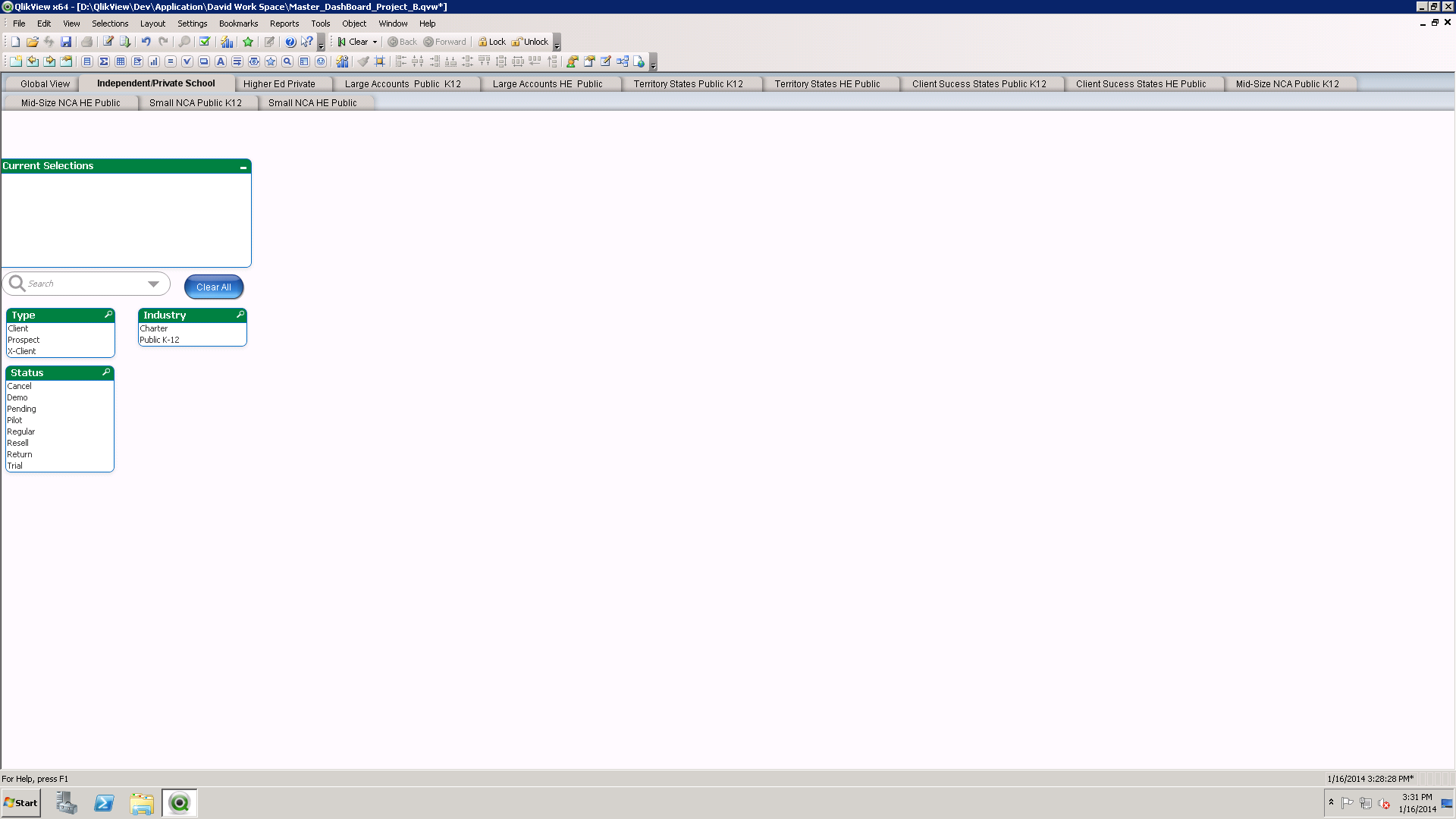Unlock a world of possibilities! Login now and discover the exclusive benefits awaiting you.
- Qlik Community
- :
- All Forums
- :
- QlikView App Dev
- :
- Tips,Ideas, Etc on Tab Views
- Subscribe to RSS Feed
- Mark Topic as New
- Mark Topic as Read
- Float this Topic for Current User
- Bookmark
- Subscribe
- Mute
- Printer Friendly Page
- Mark as New
- Bookmark
- Subscribe
- Mute
- Subscribe to RSS Feed
- Permalink
- Report Inappropriate Content
Tips,Ideas, Etc on Tab Views
Hi All,
I am loading all the data once and want to create different tabs, list boxes, and charts for the application I am working on. What I was wondering are there any tips, tricks, etc someone can share with me to help out. I have included a couple of screen shots to demonstrate what I want to accomplish. In the first picture you see the user has all the possible options for Type, Status, and Industry. Here is the screen shot:

Here is the second shot with the only thing different is I want to only show 2 Industry types but all the Types and Statuses.

I hope this makes sense.
David
Accepted Solutions
- Mark as New
- Bookmark
- Subscribe
- Mute
- Subscribe to RSS Feed
- Permalink
- Report Inappropriate Content
Hi David,
You should be able to do everything you've mentioned with a mix of section access and by using OSUser() or QVUser() depending on how you set up the document.
You can create a text box with a conditional message about the current selections. For this, I think you want to look into the function GetCurrentSelections():
getcurrentselections ([RecordSep [, TagSep [,ValueSep [, MaxValues]]]])
Returns a string with the current selections in the document.
RecordSep is the separator to be put between field records. The default is <CR><LF>.
TagSep is the separator to be put between the field name tag and the field values. The default is ': '.
ValueSep is the separator to be put between field values. The default is ', '.
Maxvalues is the maximum number of field values to be individually listed. When a larger number of values is selected the format 'x of y values' will be used instead. The default is 6.
Examples
getcurrentselections ( )
getcurrentselections ( chr(13)&chr(10) , ' = ' )
getcurrentselections ( chr(13)&chr(10) , ' : ' , ' ; ' )
getcurrentselections ( chr(13)&chr(10) , ' : ' , ' ; ' , 10 )
- Mark as New
- Bookmark
- Subscribe
- Mute
- Subscribe to RSS Feed
- Permalink
- Report Inappropriate Content
Use an expression in your listbox like:
=if(match(Industry, 'Charter', 'Public K-12'), Industry)
This will only show the two Industries.
Hope this helps!
- Mark as New
- Bookmark
- Subscribe
- Mute
- Subscribe to RSS Feed
- Permalink
- Report Inappropriate Content
If you want what is displayed based on the user, you should search the community and QV help for Section Access.
- Mark as New
- Bookmark
- Subscribe
- Mute
- Subscribe to RSS Feed
- Permalink
- Report Inappropriate Content
HI Nicole.
That hat is what I thought. I am new to Qlikview and still learning. I will look up Section Access to get a better understanding of it. That is the direction I want to go. I am creating this one document for my Sales and Marketing teams. I want to make it really easy to use with selections. I am thinking there is a way to expand so that each of my teams opens the one document and only sees the tabs that they need to see.
If I may ask another question. I believe I can create a text box the same size as my chart. Make it a top top layer and put a condtional message if there are no selections in the current selections. I have not done it before but I read it somewhere.
- Mark as New
- Bookmark
- Subscribe
- Mute
- Subscribe to RSS Feed
- Permalink
- Report Inappropriate Content
Hi David,
You should be able to do everything you've mentioned with a mix of section access and by using OSUser() or QVUser() depending on how you set up the document.
You can create a text box with a conditional message about the current selections. For this, I think you want to look into the function GetCurrentSelections():
getcurrentselections ([RecordSep [, TagSep [,ValueSep [, MaxValues]]]])
Returns a string with the current selections in the document.
RecordSep is the separator to be put between field records. The default is <CR><LF>.
TagSep is the separator to be put between the field name tag and the field values. The default is ': '.
ValueSep is the separator to be put between field values. The default is ', '.
Maxvalues is the maximum number of field values to be individually listed. When a larger number of values is selected the format 'x of y values' will be used instead. The default is 6.
Examples
getcurrentselections ( )
getcurrentselections ( chr(13)&chr(10) , ' = ' )
getcurrentselections ( chr(13)&chr(10) , ' : ' , ' ; ' )
getcurrentselections ( chr(13)&chr(10) , ' : ' , ' ; ' , 10 )